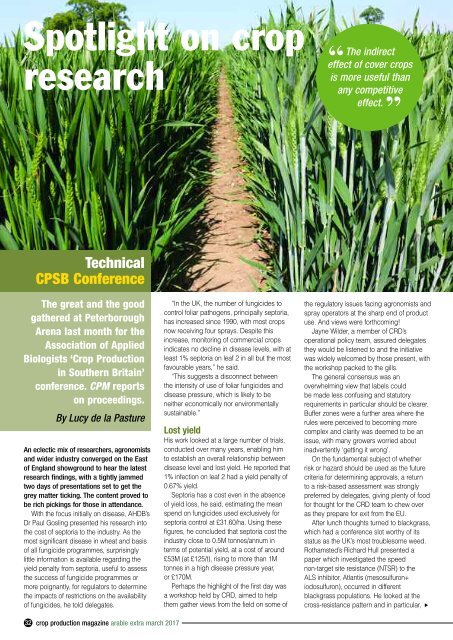In this issue..
CPM-March-Extra-2017
CPM-March-Extra-2017
You also want an ePaper? Increase the reach of your titles
YUMPU automatically turns print PDFs into web optimized ePapers that Google loves.
Spotlight on crop<br />
research<br />
“<br />
The indirect<br />
effect of cover crops<br />
is more useful than<br />
any competitive<br />
effect. ”<br />
Technical<br />
CPSB Conference<br />
The great and the good<br />
gathered at Peterborough<br />
Arena last month for the<br />
Association of Applied<br />
Biologists ‘Crop Production<br />
in Southern Britain’<br />
conference. CPM reports<br />
on proceedings.<br />
By Lucy de la Pasture<br />
An eclectic mix of researchers, agronomists<br />
and wider industry converged on the East<br />
of England showground to hear the latest<br />
research findings, with a tightly jammed<br />
two days of presentations set to get the<br />
grey matter ticking. The content proved to<br />
be rich pickings for those in attendance.<br />
With the focus initially on disease, AHDB’s<br />
Dr Paul Gosling presented his research into<br />
the cost of septoria to the industry. As the<br />
most significant disease in wheat and basis<br />
of all fungicide programmes, surprisingly<br />
little information is available regarding the<br />
yield penalty from septoria, useful to assess<br />
the success of fungicide programmes or<br />
more poignantly, for regulators to determine<br />
the impacts of restrictions on the availability<br />
of fungicides, he told delegates.<br />
“<strong>In</strong> the UK, the number of fungicides to<br />
control foliar pathogens, principally septoria,<br />
has increased since 1990, with most crops<br />
now receiving four sprays. Despite <strong>this</strong><br />
increase, monitoring of commercial crops<br />
indicates no decline in disease levels, with at<br />
least 1% septoria on leaf 2 in all but the most<br />
favourable years,” he said.<br />
“This suggests a disconnect between<br />
the intensity of use of foliar fungicides and<br />
disease pressure, which is likely to be<br />
neither economically nor environmentally<br />
sustainable.”<br />
Lost yield<br />
His work looked at a large number of trials,<br />
conducted over many years, enabling him<br />
to establish an overall relationship between<br />
disease level and lost yield. He reported that<br />
1% infection on leaf 2 had a yield penalty of<br />
0.67% yield.<br />
Septoria has a cost even in the absence<br />
of yield loss, he said, estimating the mean<br />
spend on fungicides used exclusively for<br />
septoria control at £31.60/ha. Using these<br />
figures, he concluded that septoria cost the<br />
industry close to 0.5M tonnes/annum in<br />
terms of potential yield, at a cost of around<br />
£53M (at £125/t), rising to more than 1M<br />
tonnes in a high disease pressure year,<br />
or £170M.<br />
Perhaps the highlight of the first day was<br />
a workshop held by CRD, aimed to help<br />
them gather views from the field on some of<br />
the regulatory <strong>issue</strong>s facing agronomists and<br />
spray operators at the sharp end of product<br />
use. And views were forthcoming!<br />
Jayne Wilder, a member of CRD’s<br />
operational policy team, assured delegates<br />
they would be listened to and the initiative<br />
was widely welcomed by those present, with<br />
the workshop packed to the gills.<br />
The general consensus was an<br />
overwhelming view that labels could<br />
be made less confusing and statutory<br />
requirements in particular should be clearer.<br />
Buffer zones were a further area where the<br />
rules were perceived to becoming more<br />
complex and clarity was deemed to be an<br />
<strong>issue</strong>, with many growers worried about<br />
inadvertently ‘getting it wrong’.<br />
On the fundamental subject of whether<br />
risk or hazard should be used as the future<br />
criteria for determining approvals, a return<br />
to a risk-based assessment was strongly<br />
preferred by delegates, giving plenty of food<br />
for thought for the CRD team to chew over<br />
as they prepare for exit from the EU.<br />
After lunch thoughts turned to blackgrass,<br />
which had a conference slot worthy of its<br />
status as the UK’s most troublesome weed.<br />
Rothamsted’s Richard Hull presented a<br />
paper which investigated the speed<br />
non-target site resistance (NTSR) to the<br />
ALS inhibitor, Atlantis (mesosulfuron+<br />
iodosulfuron), occurred in different<br />
blackgrass populations. He looked at the<br />
cross-resistance pattern and in particular,<br />
▲<br />
32 crop production magazine arable extra march 2017


